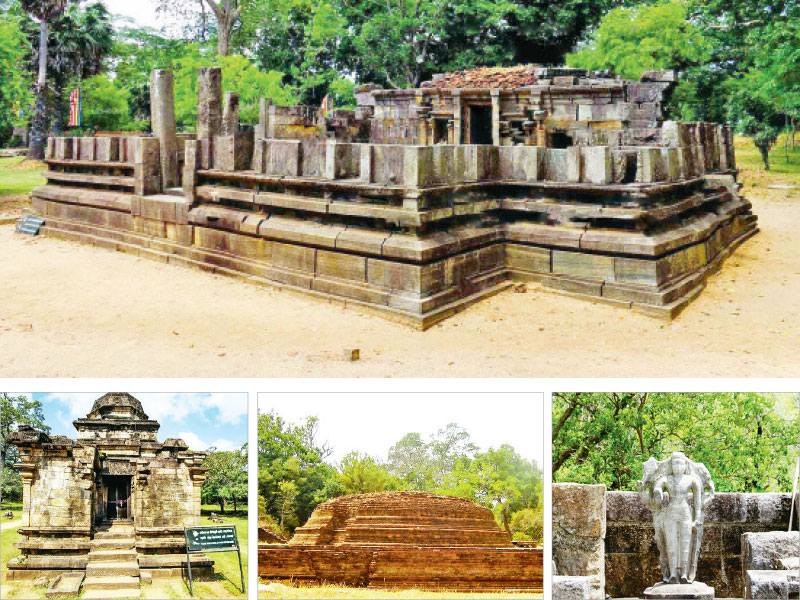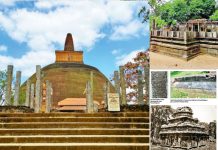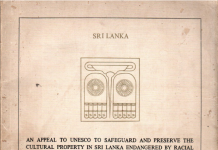“The seed of cultural harmony lies not in the culture you are born in but in the recognition of the sweetness of other cultures.”
—Abhijit Naskar, Sleepless for Society
Cultural heritage pays a price in times of war and unrest. People target cultural heritage to attack another group due to the ideologies, and intangible cultural and religious values attached to the tangible heritage associated with another group of people.
We have witnessed incidents of such globally and nationally. For a country that has had its fair share of racism and terrorism, we know all too well how these can negatively affect the heritage of the country.
Vandalising, looting, bombing, disfiguring, and encroaching are things that heritage has to withstand in times of conflict.
Ethnic issues, a threat to heritage
In Sri Lanka, present-day ethnic issues and racism are one of the biggest threats that the country’s heritage faces. Therefore, rebuilding the burnt bridges between the two main communities – the Sinhalese and the Tamil – is crucial to safeguard heritage. Peace protects heritage.
For months, Ceylon Today has brought to you instances of how unrest, war, and racism are damaging Sri Lanka’s cultural heritage. Therefore, we insist on the importance of a better understanding between the Sinhala and Tamil communities of Sri Lanka, and the need of building bridges of peace, harmony, and reconciliation between the two communities. This is not only beneficial to the heritage but largely beneficial to the country as a whole to its development.
In this process of establishing peace between the Sinhala and Tamil communities, it is essential to widen the understanding between each other. During our research, we have understood that there are many misunderstandings, misjudgements, and prejudices between the Sinhalese and the Tamil. One main reason we understood is the lack of understanding of each other’s history, culture, and language. Therefore, we suggest that history education and learning each other’s languages are crucial in rebuilding bridges of peace between the two communities. In the absence of the truth, many misconceptions grow and opportunists make the best use of this gap and fill it with misinformation. Also, due to these misunderstandings and lack of understanding of each other’s legacy, racist politicians play dirty games. Thus, we emphasise the importance of teaching Sri Lanka’s history (unbiased and scientific), Sinhala, and Tamil languages to both communities at schools.
Ceylon Today has explored the history and culture of the Sinhala race in many of our previous segments. Therefore, from now on, we shall dedicate some time to embark on an adventurous and enlightening journey to witness the legacy of the Tamils in Sri Lanka.
Tamils in Sri Lanka
The Tamil community, their culture, language, and legacy are at present an important part of Sri Lanka’s legacy. The diversity of Sri Lanka’s culture makes it unique and beautiful. Although it is a fact that the Sinhala race was the race that built the civilisation of this island, we cannot ignore the fact that many other ethnicities and groups of people contributed to the diversity of the country’s culture. We also believe that, no matter how it was during the early historic times, today, the Tamil community is a vital part of Sri Lanka’s demography and culture. If someone is standing for a pure Sinhala-only state, that, we feel, is similar to demanding a pure Tamil-only state. We need to look at the present situation of the country and understand that we cannot exclude the Tamil culture from the Sri Lankan culture.
Also, the strong bond between the Sinhala and Tamil cultures in Sri Lanka is something interesting to study. This also helps us to clarify certain misunderstandings. Also, we believe that once there is a better understanding between the Sinhala and Tamil communities about each other, racist politicians, individuals, and separationist groups have a lesser chance to provoke innocent civilians against each other.
Also, compulsory history and language education at schools will give all citizens a clear understanding of the country’s history and not distorted and fabricated fables that fuel the fire.
In Sri Lanka, the Hindu culture plays a significant role. Although historically Sri Lanka has been a Buddhist State, the cultural heritage of present-day Sri Lanka has been significantly influenced by Hindu culture since Polonnaruwa Period. According eminent to scholars such as Prof. Senerath Paranavitana Tamil people had been living in Sri Lanka during the Anuradhapura Kingdom. Prof. Paranavitana even identifies inscriptions of Tamil Buddhists. According to the Mahavamsa or The Great Chronicle, King Chandramuka Siva (44 – 52CE) of Anuradhapura had a ‘Demala Devi’ (Tamil queen) who had contributed to the development of Buddhist temples. This Demala Devi could be a princess from a South Indian kingdom that spoke Tamil as their mother tongue. We need to study this further.
During the time of Polonnaruwa, the Hindu religion was prominent. For the first time, Hindu devalas for gods such as Siva, Visnu, and Kali were built in Sri Lanka. Many stone Siva lingas and bronze statues of Siva, Ganesh, and Parvati were found that belonged to the Polonnaruwa Period.
Nandi is the sacred bull of the god Siva. Siva is the mightiest god for the Hindus. Therefore, the bull which is sacred to the Hindus was removed from the moonstone as a gesture of respect. This is a great act of religious harmony, respect, and reconciliation. We doubt that there are any other similar examples in the history of the world to prove how people in Sri Lanka respected each other’s religions and beliefs.
Also, we have records to say that during the rule of the Cholas in Sri Lanka, they had patronised Buddhist temples by providing offerings and donations. The best example is the donations at Velgam Vehera. The inscriptions bear evidence. At Velgam Vehera there are inscriptions about offerings by Tamil Buddhists. However, we must note that the Cholas were Hindus although they did offerings at Velgam Vehera.
After King Vijayabahu the Great defeated the Cholas and re-established the Sinhala monarchy, he revived Buddhism. He is one of the greatest Sinhala warrior kings and great patronage of Buddhism. Yet, there are no historical textual or archaeological records to believe that king Vijayabahu or any of his successors destroyed or disfigured the Hindu kovils built in Polonnaruwa. They were not refashioned as Buddhist monasteries. They continued to function as Hindu kovils. To date, these beautiful structures are cherished as a part of Sri Lanka’s rich cultural heritage and are well-protected.
During the post-medieval times, especially during the time of the Gampola Kingdom, Hindu shrines were built inside the Buddhist temple. And later, idols of deities were placed inside the Buddhist image house beside and/or in front of the Buddha statues. Among these many gods, there are Hindu gods such as Siva and Visnu.
One reason for this was that during these times, the Sinhala kings had queens of South Indian origin who spoke Tamil and Telugu as their mother tongues and who practiced Hinduism.
The practice of marrying South Indian princesses by Sinhala kings resulted in setting the stage for the Nayakkar kings to come into power, during the Kandyan Kingdom. As a result of this, we witness the rise of four Nayakkar kings in power. All four of them were called the Udarata Maha Raju or the Great King of Kandy and not by the name of their ethnicity. These four kings ruled as fair kings who patronised Buddhism and pleased the monks and the citizens. It was the power-hungry Kandyan chieftains who rebelled against the king. A statue of King Keerthi Sri Rajasinghe is built inside of the caves at Dambulla Raja Maha Vihara as a tribute to this king who did a great service for Buddhism. Their queens and their relatives remained Hindu. Hindu shrines were built for their use within the Kandy Sri Dalada Maligawa premises.
Exploring the journey of Tamils in Sri Lanka
In our following article, we will explore the journey of Tamils in Sri Lanka. We will learn about the earliest Tamil settlement in Sri Lanka, about Tamil inscriptions in Sri Lanka, and also about Tamil Buddhists in Sri Lanka. Like the Damila Devi of King Chandramukha Siva, who was a Buddhist, there had been Tamil monks and Tamil Buddhist scholars in Sri Lanka and South India. We will also learn about the offerings at Velgam Vehera and what the Cholas did at Velgam Vehera. Also, we shall understand how Jaffna became predominantly Tamil and if and how a Tamil kingdom was established in Jaffna. We also need to understand the various political, cultural, and religious alliances the Sinhala kingdom shared with South Indian kingdoms, including marriages.
These understandings help us to broaden our perspective on each other’s culture and the issues they are facing. Also, understanding the accurate history of Sri Lanka is crucial to know that the stories about a historical Eelam are merely a myth and that in the past Sinhala and Tamil, communities have been living in harmony in Sri Lanka without demanding a separate Tamil-only state. Hiding accurate history or distorting history is not the answer to solving the ethnic issue, but facing the historical reality and accepting the historical reality is the way to answer the demand for an Eelam.
“History is who we are and why we are the way we are.”
—American historian David McCullough
(To be continued…)
By Ama H. Vanniarachchy
Heritage: Ambassadors of peace (Part I)





